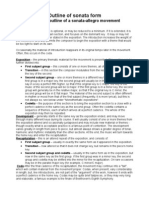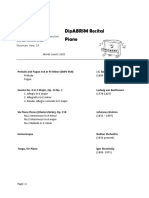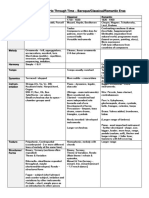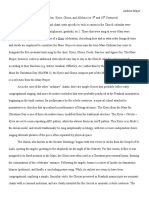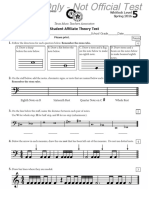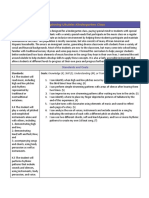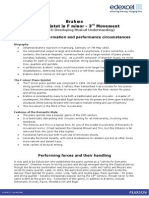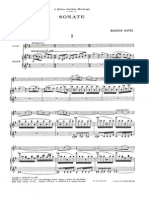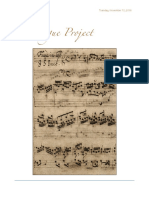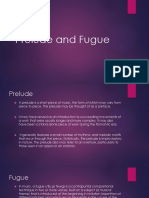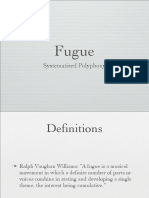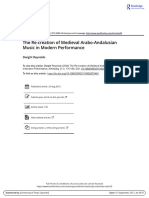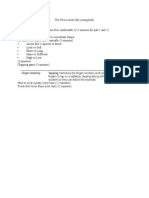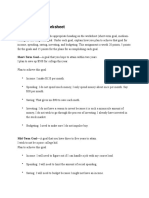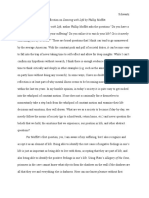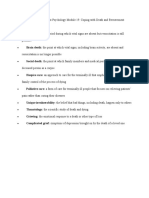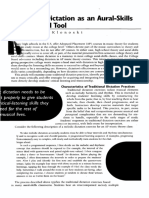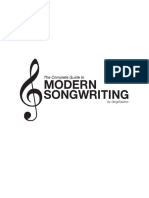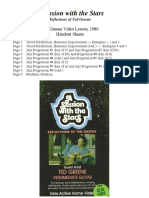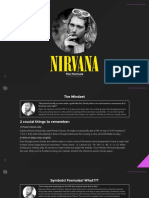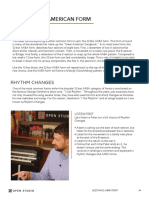F&A Brief Guide to Fugue Analysis
The following outline gives some guidance for an approach to fugue analysis. Terminology is far from standard
and in any case must be adapted to fit the musical demands. It is important to grasp the sense of each term and
apply it consistently.
You should be able to define, discuss, and relate the following:
fugue countersubject subject-absent
subject link middle entry
answer exposition entry group
real imitation episode free counterpoint
tonal imitation subject-present stretto
I. Exposition - The initial entry group presents the subject or answer in each voice. The end is usually marked
by a cadence. An exposition may contain more entries than the actual number of voices. For example, a
three voice fugue may contain 4 subject entries in the exposition. This 4th entry is called a redundant entry
(or false voice entry). It is usually in a different register than the initial entry in the same voice and has the
aural effect of a 4th distinct voice.
A. The subject
1. Melodic aspects: tonality, scale degrees of structural pitches, diatonic or chromatic, prominent
intervals, basic contours, motivic structure (sequential treatment, development, non-motivic
elaboration, intervallic expansion), function of motives, harmonic implications, open or closed
ending
2. Rhythmic aspects: meter, placement of beginning in meter, rhythmic motives, length, tempo, degree
of rhythmic variety
B. The answer (imitation of the subject)
1. Real (exact) or tonal (altered), how altered and why altered (prominent dominant, modulating
subject)
2. Pitch interval, usually a 5th related, others possible
3. Time interval, rhythmic distance between entries
C. The countersubject
1. Melodic and rhythmic aspects (see l.A.), suggested motives or fragmentation
2. Degree of preservation in subsequent entries
3. Derivation of material (if any)
4. Contrapuntal devices, invertible counterpoint
D. Other material
1. Pattern of entries, imitative intervals
2. Harmonic content. Implied harmonies at beginnings and endings
3. Link (or linking episode), why or why not?
4. Contrapuntal relationships between parts
5. End of expo, cadence, what key? Degree of closure
II. Subject-present sections
A. Subject-present sections contain at least one complete statement of the subject (or rarely the answer).
After the exposition these are usually referred to as entry groups. Entries within entry groups may be
called middle entries or the entire entry group may be called a middle entry group. A second complete
round of subject-answer entries immediately following the exposition is called a counterexposition.
B. A variety of developmental and contrapuntal techniques may appear in middle entry groups. Be alert for
any of the following:
� 1. Key scheme - usually closely related to the main key. Look for possible rationale for choice of
keys.
2. Form of subject – subject, answer, melodically altered, change of mode. Most important, try to
explain why the changes are present, to what musical effect or compositional purpose?
3. Variations of earlier material - inversion, diminution, augmentation, retrograde, fragmentation
C. Concluding section - The final entry group is often constructed in such a way to provide an appropriate
tonal and melodic conclusion to the piece. A short episode or coda may occur in conjunction with this
section.
D. Large scale structure
1. Tonal scheme, internal and in relation to the whole
2. Order of entries, relation to exposition and other groups
3. Imitative intervals - stretto (overlapping of entries), additional links
III. Subject-absent sections
A. These are sections in which there is no complete statement of the subject (or answer) and provide
melodic and tonal contrast to the subject-present sections. They often serve to modulate between the
keys of entry groups. A short episode that occurs within an entry group, usually between the answer and
the subject, and serves as a tonal bridge between the two is called a link (or bridge). Episodes between
entry groups are simply called episodes, although they often serve the function of a modulatory link
between entry groups.
B. Features of episodes - consider:
1. Derivation of melodic material, subject, answer, countersubject, free counterpoint, combinations.
2. False subject entries (contrasted with subject fragments)
3. Treatment of material - sequence, direct repetition, alternation, development (aug., dim., inversion,
etc.)
4. Tonal instability or brief exploration of remote key areas
5. Formal or tonal function of the episode, relationship to other episodes
IV. Other considerations
A. Fugue refers to a particular class of single movement, imitative works that follow certain fairly
predictable patterns of contrapuntal and formal procedures. Analytic interest lies in how a well- crafted
musical work is brought forth from the unique application of these procedures.
B. Formal design varies from fugue to fugue, even within works of the same composer. Consider the
design of each piece carefully. Most fugues can be initially divided into an exposition, middle section,
and concluding section. Each section can then be farther parsed according to the nature of the material.
C. Consider the following aspects of large-scale form and design:
1. Tonal scheme - move away from and return to main key
2. Cadence structure, relative degree of conclusiveness of internal cadences
3. Repetition of large portions of material, especially in episodes
4. Proportions - length of subject, number of entry groups, point of greatest tonal instability, overall
contour, etc.
5. Techniques for delineation of principle sections
6. Relationship of key and subject to apparent emotional content, affect
7. Influence of the performance medium
V. Multi-subject fugues - Fugues with 2 (double), 3 (triple), 4 (quadruple), or 5 (quintuple) different
subjects are possible. These can be analyzed with similar procedures and terms. Note especially the way
in which the various subjects are presented. Subjects may be presented simultaneously or in separate
expositions. Many variations of design are possible. Note the way in which one subject fits
contrapuntally with the other. Are there details built into the subjects that facilitate this?

